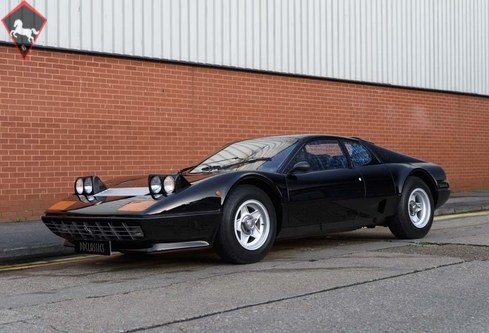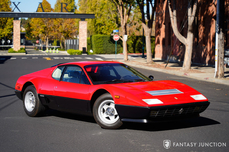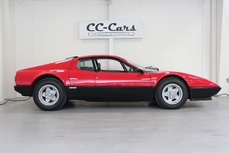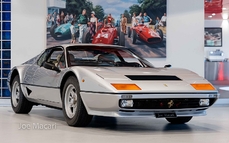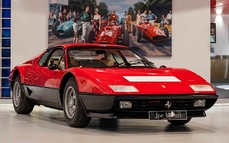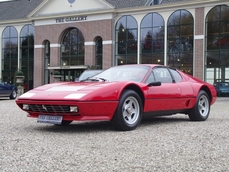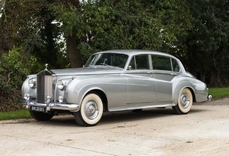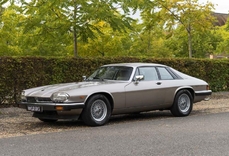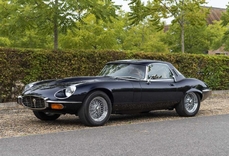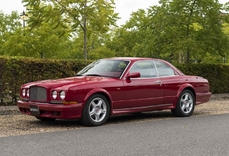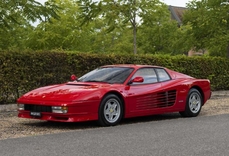Ferrari 512 BB (RHD) 1981
Allmän beskrivning :
Fabulous example
Beautiful Jet black with Black leather interior
Maintained to a high standard
One of the very best available.
1981 Ferrari 512BB (RHD)
At its debut at the Paris Show in 1976, the 512 BB was equipped with a 5-litre version of the 12-cylinder boxer. The new engine proved a great success, giving the same power at lower revs, better torque and a smoother delivery than the earlier version in the 365 GT4 BB. The Pininfarina coachwork differed only slightly from the previous model in certain details which not only made it look even more elegant but also helped improve engine cooling.
The 512 BB was announced at the 1976 Paris Salon, replacing the 365 GT4/BB, and continued in production until 1981 when it was replaced by the 512 BBi, on which fuel injection replaced the carburettors. A total of 929 examples were produced during this period in the chassis number range 19677 to 38487. The new model title was far less of a mouthful than its predecessor, and broke with standard Ferrari practise of referring to the swept volume of a single cylinder. Instead it continued the theme started with the Dino series, of referring to the total engine capacity and number of cylinders. Hence it meant a 5 litre engine with 12 cylinders. The “BB” part of the model title had the same meaning as before “Berlinetta Boxer”, a reference to the two banks of six cylinders that were in a horizontally opposed layout. The basic principles, shape and features were similar to those of the model that it replaced, but there were small visual differences that differentiated the two cars, whilst under the skin the biggest difference was the increased capacity of the engine.
Visually the differences between the 512 BB and the 365 GT4/BB were mainly around the nose and tail. The lower nose panel now incorporated a chin spoiler, and at the rear the triple tail light assemblies and triple exhaust pipes gave way to large twin circular lenses and paired twin exhaust pipes. The twin tail light arrangement mirrored that shown on the original prototype displayed at the 1971 Turin Salon. The mesh tail panel of the 365 GT4/BB was replaced by a satin black finished horizontally louvred panel, with further changes to the louvre arrangement on the engine lid. The body sides received NACA ducts forward of the rear wheel arches to cool the exhaust system, whilst the rear track was increased from 1520mm to 1563mm. The body was mounted on a 2500mm wheelbase chassis, that had factory reference number F 102 BB 100, and all were numbered in the odd chassis number road car sequence. The construction followed the same principles as that of the 365 GT4/BB of a tubular steel chassis frame with a monocoque central cell. Again as with the 365 GT4/BB, the 512 models were available in right or left hand drive form, but no USA market versions were ever made. The standard road wheels were alloy five spoke “star” pattern, with a knock off spinner on a Rudge hub, although legislative requirements in some markets dictated the fitment of a large octagonal hub nut. The wheels covered large ventilated disc brakes with twin hydraulic circuits, and servo assistance. Independent suspension was provided all round, via wishbones, coil springs, and hydraulic shock absorbers, with twin rear units, together with front and rear anti roll bars.
The flat twelve cylinder engine was of the same configuration as that fitted in the 365 GT4/BB, but with a cubic capacity of 4943cc, and 82mm x 78mm bore and stroke, with factory type reference F 102 B 000. It featured belt driven twin overhead camshafts per bank, with the basic construction, operating principles and layout of the engine and transmission, apart from the adoption of dry sump lubrication and a hydraulically operated clutch, the same as the 365 GT4/BB. The 512 BB was fitted with four triple choke Weber 40 IF 3C carburettors, with a single distributor, driven off the left rear inlet camshaft and electronic ignition system, to produce a claimed 340 bhp. Although the earlier 365 GT4/BB produced more power than its later relative, the larger engine offered greater torque and improved driveability. The Berlinetta Boxer had a competition career from the late seventies into the mid eighties, mainly instigated by the concessionaire for the USA, Luigi Chinetti. Their main hunting ground was the GT category at Le Mans, and from the early lightly modified road cars, he persuaded the factory to develop a racing version, the 512 BB LM, which was built at Ferrari’s Assistenza Clienti in Modena, with radically different bodywork developed in Pininfarina’s wind tunnel. They were built in two small series for private clients, but they were never raced as works team cars. The best results at Le Mans were a win in the IMSA category and fifth overall in 1981, and sixth overall in 1982.
Now available for viewing at the DD Classics Dealership in London, please call to book an appointment.
http://ddclassics.com/car-listing/ferrari-512bb-rhd/
1981 Ferrari 512 BB (RHD) is listed såld on ClassicDigest in Surrey by DD Classics for Ej prissatt.
Fakta i bilen
Karosstyp : Personbil Märke : Ferrari Modell : 512 BB Modellversion : (RHD) Motorvolym : 0.0 Årsmodell : 1981 Karosstyp : Race/Rally Car Läge : Surrey
Såld
Information om säljaren
Såld
People who viewed this Ferrari 512 BB also viewed similar Ferrari listed at ClassicDigest
Other cars listed for sale by this dealer
om Ferrari
Den första Ferrari väg bil var de 125 S introducerades 1947 och drivs av en 1,5 L V12 motor, eller hur?Tja det är inte riktigt så enkelt, Ferrari faktiskt producerar e Tipo 815, 1940 Tipo 815 ritades av ex-Alfa Romeo ingenjörer Alberto Massimino och Vittorio Bellentani och Enrico Nardi enligt Enzo sällskap men juridiska frågor med det tidigare intresse Alfa Romeo hindrade Ferrari från att lansera Ferrari marque vid den punkten.
Enzo fick fram en rad fina väg bilar på 50-talet och 60-talet, men de var bara för att finansiera sin passion racing, väder GT / Sportbil eller Grand Prix. 50-talet såg födelsen av Ferraris mest minnesvärda bilar, 250 GTB (tour de France) 250 Testa Rossa, 250 GT SWB bara för att nämna några.
Under ytspänningen växte dock. I November 1961 erfaren försäljningschef Girolamo Gardini gjorde ett ultimatum till Enzo: om spänningar fortsatte skulle han lämna företaget. Som ett resultat var Gardini avsattes, liksom Scuderia Ferrari manager Romolo Tavoni, överingenjör Carlo Chiti, experimentell sportbil utveckling chief Giotto Bizzarrini, och ett antal andra, som stod vid dem.
Utan Chiti och Bizzarrini utvecklingen av vad som skulle bli den mest kvintessensen Ferrari och idag världens dyraste bil, 250 GTO, var vid en svängpunkt. 250 GTO projekt räddades av en ung ingenjör Mauro Forghieri och lång tid racing bodyman Sergio Scaglietti som klev in och tog över programmet med kända resultat.
Förutom 250 GTO, Ferrari launced sådana mästerverk som 250 LM, 250P, 275 GTB, 365 GTB / 4 "Daytona" under 60-talet
I slutet av 60-talet Ferraris prototyper framgång fick ett abrupt stopp av en ny konkurrent, GT40. Ford vände sig till Lola för att producera en Ferrari slog långdistans racer efter Enzo hade klippt affären av med Henry Ford II gör det senare absolut koka av vrede. Samarbetet mellan Ford och Lola skapade den mäktiga Ford GT40 som gav Ferrari några tunga hits i Le Mans 24 framöver.
I slutet av 60-talet FIAT köpte 50% av bolaget, med start en utveckling som har lett till en ny massproducerade era av Ferraris.
Oavsett om du säljer eller letar efter en klassisk Ferrari www.classicdigest.com är platsen att kolla ut.
